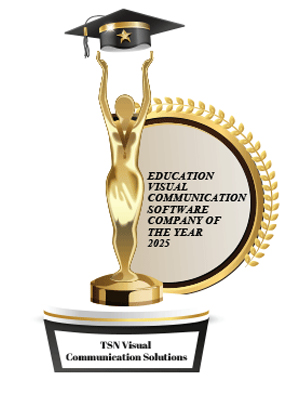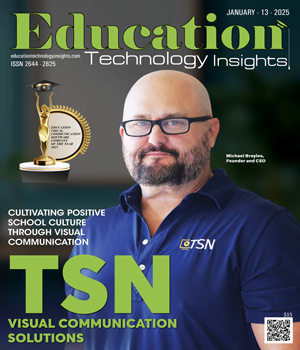THANK YOU FOR SUBSCRIBING
Be first to read the latest tech news, Industry Leader's Insights, and CIO interviews of medium and large enterprises exclusively from Education Technology Insights
Remember the school bulletin board? That cluttered corkboard filled with flyers, schedules, announcements and student artwork was once the pulse of school communication. It was where students, teachers and staff connected with the daily rhythm of campus life. While these boards still hold a place in many schools, the spirit of school communication has found new energy with TSN Visual Communication Solutions. It reimagines the traditional bulletin board with vibrant digital displays. More than just announcements, each screen becomes a vivid canvas, telling stories reinforcing positive community values that all schools and parents strive for. It also invites active participation between students and staff. “We believe that a better-informed and engaged student is a better citizen, and that begins with empowering young minds in elementary, middle and high schools,” says Michael Broyles, founder and CEO. “Our platform fosters that connection and engagement, helping schools build a positive culture where students are better informed and actively involved in meaningful ways. We do this in a dynamic way that is familiar to students.” Technology has moved beyond slides and presentations; students expect and deserve more. These older approaches and technologies still serve their purposes—as integrated features. But they no longer work as complete standalone solutions. An elementary school principal witnessed this firsthand during a reading challenge. Initially, student participation was low. However, the event quickly gained momentum after using TSN’s platform to feature pictures of students who met their reading goals. The moment the first student saw her photo on the school’s digital screens with a congratulatory message, excitement spread. Other students soon hit their goals, eager to see their faces on the screen. What started as an individual challenge evolved into a school-wide success with increased parent involvement. This brings student participation and success to the forefront and makes that the foundation for a positive and uplifting school culture. This is what TSN does, and what makes it stand out among other educational visual communication solutions. By celebrating students and their accomplishments, it helps schools shape a narrative that reflects their values, fostering pride and participation. Communication that Reaches Every Corner of the School Community TSN’s platform empowers schools to tailor content that resonates with their diverse communication needs and audiences—students, staff and parents alike. Its pre-created content libraries addressing various topics enable schools to quickly deliver materials based on grade level. For instance, while high-schoolers might engage with an anti-bullying video, the appropriate message for elementary students might be an image of animated characters holding hands with the message, ‘Be a Friend.’ Bringing this flexibility allows schools to craft messages that resonate with every student. The platform also accommodates the complex communication needs of K-12 schools based on the location within the campus. The system is built with multiple layers to achieve this, offering sets of ‘connections’ that focus content delivery on specific areas. These connections include Campus Connect for hallways and common areas, Classroom Connect for interactive classroom panels, Athletic Connect for sports facilities and Cafeteria Connect for menu boards. A modular platform design ensures each department benefits from relevant messaging and avoids overlap with specific tools and features designed for the specific use case, user base and audience type of each connection.
CXO INSIGHTS

Beyond Compliance to Wellbeing and Belonging in Course Design
Gloria Doherty, Director of Digital Learning at George Fox University

How AI is Shaping the Classroom of Tomorrow
Jean Mandernach, Executive Director, Grand Canyon University

Innovative Strategies for Global Education and Assessment
Dr. Eric A. Canny, Assistant Teaching Professor of Education, University of Southern California

Creating a Culture of Data Protection
Karla Lellis, Adjunct Professor, Data Privacy Compliance at State University of New York at Oswego

Data to Life: How Learning and Employment Records Tell Working Adult Students Whole Stories
Doris Savron, MBA, Vice Provost, Colleges, Assessment and Curriculum at University of Phoenix
IN FOCUS
Exploring How Technology Enhances Student Engagement in Higher Education
In today's digital age, technology has become an integral part of everyday lives, transforming various aspects of society, including education.
Enhancing Learning Through Visual Media
The integration of visual communication in education has revolutionized the way knowledge is disseminated and absorbed.
EDITORIAL
The Power of Visual Communication in Education
In an era dominated by digital innovation, the role of visual communication in education has become increasingly pivotal. As educators grapple with the challenges of engaging diverse learners, visual tools offer a dynamic and inclusive way to bridge gaps in understanding and enhance learning experiences. The human brain is wired to process visuals more efficiently than text. Studies indicate that people retain 80 percent of what they see and do, compared to only 20 percent of what they read. This makes visual communication an invaluable asset in classrooms, where students must absorb and apply complex concepts quickly. From kindergarten to university, educators are leveraging visual aids such as infographics, videos, diagrams, and interactive graphics to make abstract ideas tangible. For example, science teachers use animated simulations to explain molecular behavior, while history educators rely on timelines and maps to provide contextual understanding. Moreover, visual communication caters to diverse learning styles. Visual learners, who make up a significant portion of students, thrive on images, charts, and other graphic representations. For auditory and kinesthetic learners, visuals serve as a complementary tool, reinforcing lessons and encouraging collaboration. Visual communication is no longer a supplementary element in education—it is a cornerstone of modern pedagogy. By embracing this powerful tool, educators can create engaging, inclusive, and effective learning environments that prepare students for the complexities of the 21st century. However, its implementation must be thoughtful and equitable, ensuring that all learners reap the benefits of this visual revolution. In this edition, we have featured TSN Visual Communication Solutions. The company views educational visual communication as a way to build and maintain a positive school culture rather than just a messaging tool. Focusing on positive values and engaging students with relevant content enhances their learning environment and fosters community involvement. Integrating safety features further supports students’ well-being. This holistic approach keeps students informed, engaged, and connected, leading to better outcomes.
I agree We use cookies on this website to enhance your user experience. By clicking any link on this page you are giving your consent for us to set cookies. More info

However, if you would like to share the information in this article, you may use the link below:
www.educationtechnologyinsightsapac.com/edition/13-January-2025-7.html








